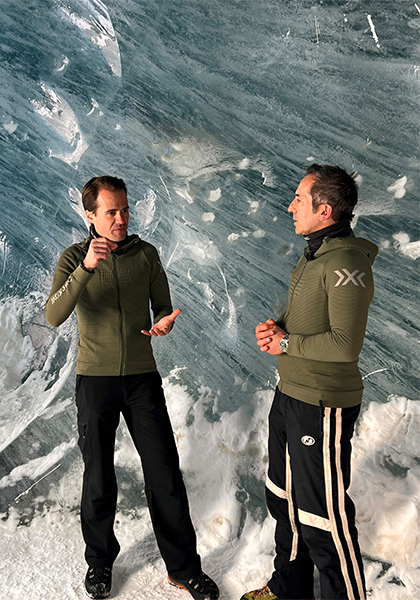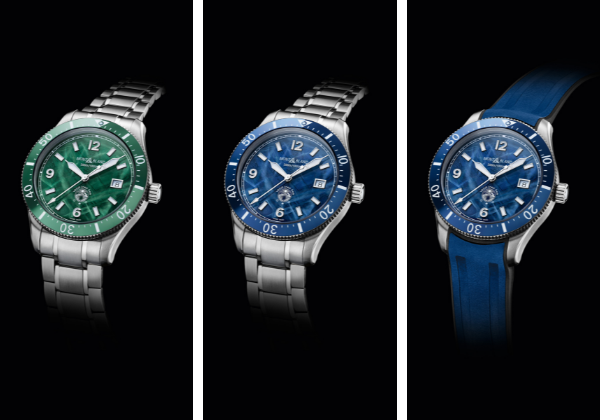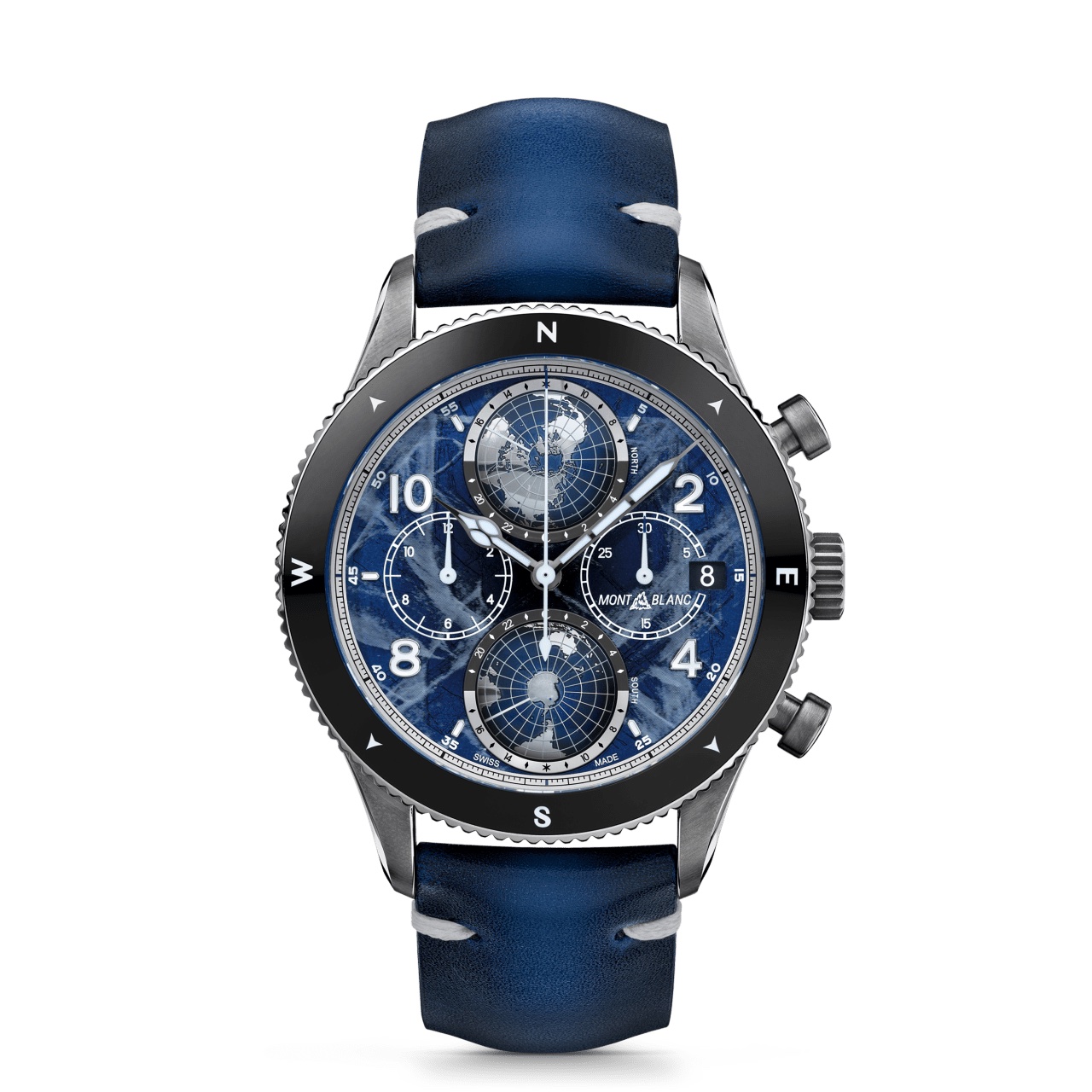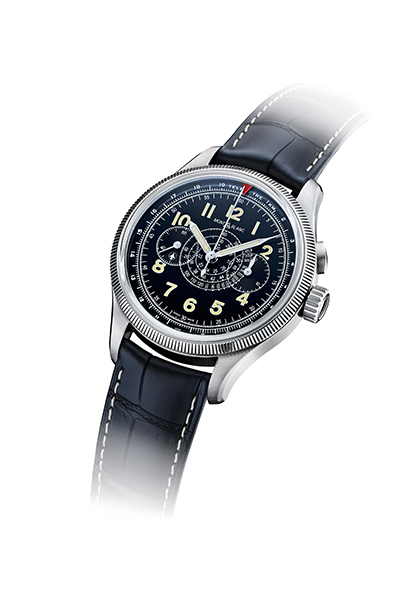A Montblanc dive watch. I didn’t see that coming!
It’s a first. When I arrived at Montblanc last year, I spent a long time going through books and archive documents. I wanted to really understand the brand’s origins, and this led me to look more closely at the Montblanc logo, with its six valley glaciers. As someone who enjoys being outdoors, especially around mountains, I came up with the idea of taking the glacier concept and applying it to a watch. After all, who better than Montblanc to create a watch inspired by glaciers? So, my team and I went to the famous Mer de Glace glacier to study its contrasts and colours, with the aim of reproducing them on a dial. We knew that, from a technical point of view, recreating the veins, ridges, reflections and depth of a glacier on a dial just 0.4mm thick would be no small challenge. Dozens of prototypes later, we had what we wanted. The effect is quite remarkable.
The reference to glaciers is something I can relate to, because of my love of nature and mountains, and also because I’ve always been impressed by performance in sport. Sports watches have always worked well at Montblanc and from there, it was only a short step to making a dive watch. Nature inspired us to take that step, up there on the Mer de Glace. The largest glaciers descend into the sea, icebergs float on the sea, so this association of glaciers with a dive watch made perfect sense. And because our 1858 collection is about exploration and conquering new terrain, it was the natural home for this new watch.

What else can you tell us about the 1858 Iced Sea Automatic?
First and foremost, this is an authentic dive watch that meets all the requirements of the ISO 6425 standard. It is antimagnetic, has a depth rating of 300 metres and is resistant to shocks and extreme temperatures. It’s also an atypical and unique dive watch, being the only one whose caseback bears a three-dimensional engraving of a glacier, the ocean and a diver carrying a diving cylinder to represent underwater exploration. Glaciers in nature display three colours – blue, green or black – which we have transposed to three versions of the watch. As well as being aesthetically pleasing, the V-shaped strap [20mm wide between the lugs and 16mm at the folding clasp] ensures great wearing comfort, is adjustable and can be easily swapped in and out. Very few watches offer this triple combination. The ceramic bezel adds to perceived value and reinforces the unique design of the iced dial, with its 3D, SuperLuminova numerals. All for under €3,000!

What techniques did you employ to create the dial?
A very old dial-making technique that uses gutta-percha, a natural rubber from latex that becomes porous when hot water is poured over it. The dial sits just above a gutta-percha plate and is gently scratched with a brush whose bristles are 0.4mm thick, so as not to damage the surface. This is also why we use only natural products for this process. This technique is one of the secrets behind the extraordinary rendering but not the only one. Each dial is actually the result of thirty separate sequences.
You’re extending the iconic Geosphere collection with a chronograph, equipped with a new, zero-oxygen movement.
Our Geosphere collection has close ties with one of our key Mark Makers, Reinhold Messner. In 1978 he became the first person to reach the summit of Mount Everest (8,848 metres) without supplemental oxygen. His exploit gave us the idea for another: what if a mountaineer were to make the same ascent and to do it wearing the first ever zero-oxygen chronograph!
The next question was, who would be capable of such a challenge? Of the mountaineers who succeed in scaling Everest, virtually none of them do so without the aid of supplemental oxygen. We consulted with Reinhold Messner who immediately suggested Nimsdai Purja. He has set numerous mountaineering records, including the fastest ascent of all fourteen “eight-thousander” summits, in under seven months, pulverising the previous record of almost eight years!
This coming May, Nimsdai will set out to climb Mount Everest without supplemental oxygen and, in what will be the ultimate test for the watch, wearing the 1858 Geosphere Chronograph 0 Oxygen LE290. Oxidation of the components and oils in the mechanism is virtually zero. Also, the humidity that can form as a result of extreme temperature variations will never penetrate the watch.
The caseback is a story in itself. We’ve used our laser oxidation technology on titanium to reproduce the contours, depth and colours of one of the faces of Everest… but not just any face. This is the one Messner climbed in 1978 and again in 1980, both times without supplemental oxygen. It’s also the face that Nimsdai will be tackling in May. Once again, past, present and future come together.

What do Montblanc watches have that others don’t?
Montblanc watches offer their own form of innovation, whether this is aesthetic, technical, even emotional.
Look at a Nicolas Rieussec watch, for example, with its in-house movement, and you’ll notice the two off-centre dials that single it out from any other watch.
There’s also the Geosphere with a unique complication comprising two half spheres that indicate the time in the Northern and Southern hemispheres, and which give the watch its distinctive, immediately recognisable personality.

Then there are our Haute Horlogerie watches such as the Red Arrow, whose bezel looks to the 1920s and 1930s when our Minerva manufacturer incorporated an arrow into a fluted bezel that made it possible to provide two functions.
And this is just the start of the ascent…






